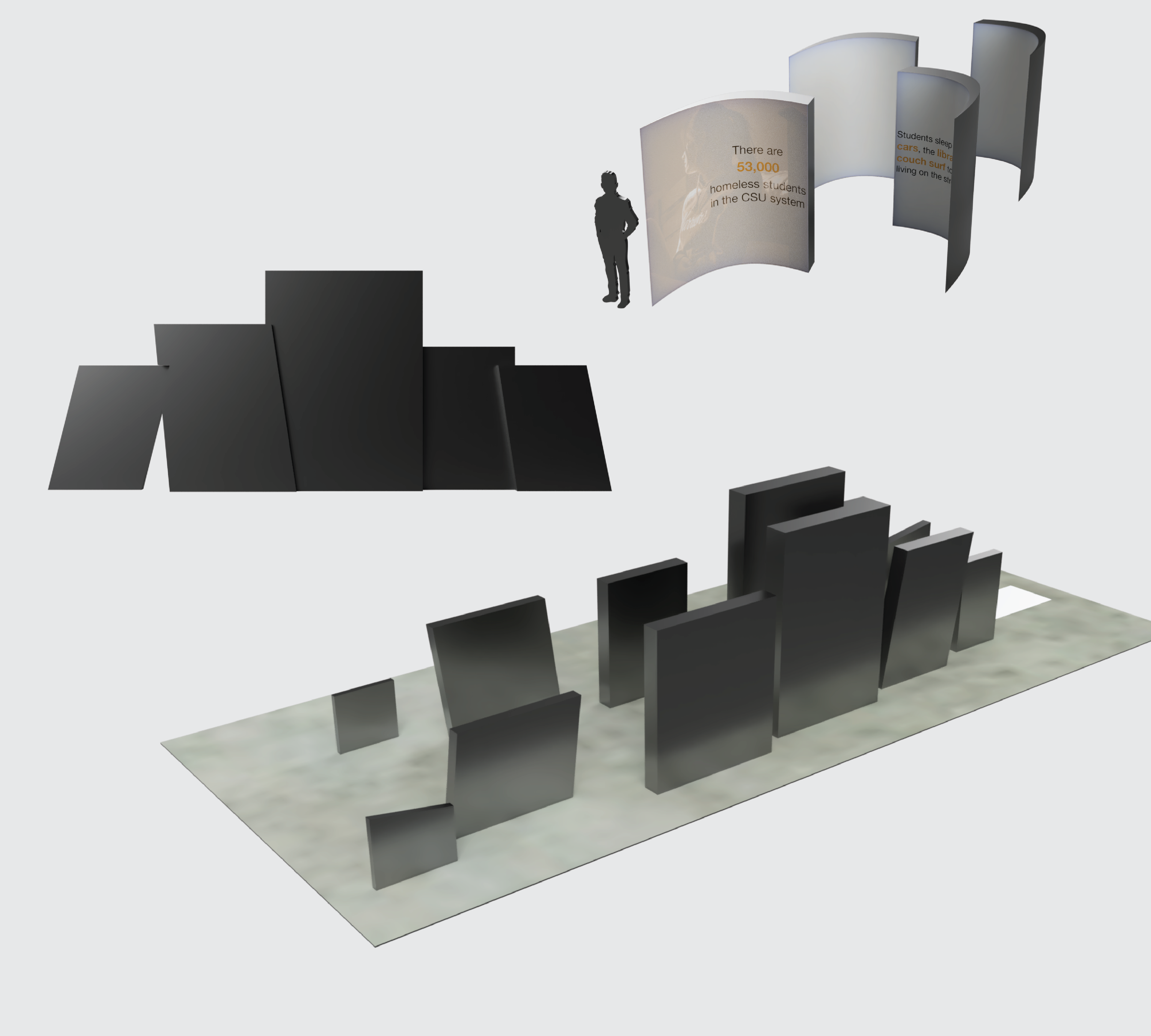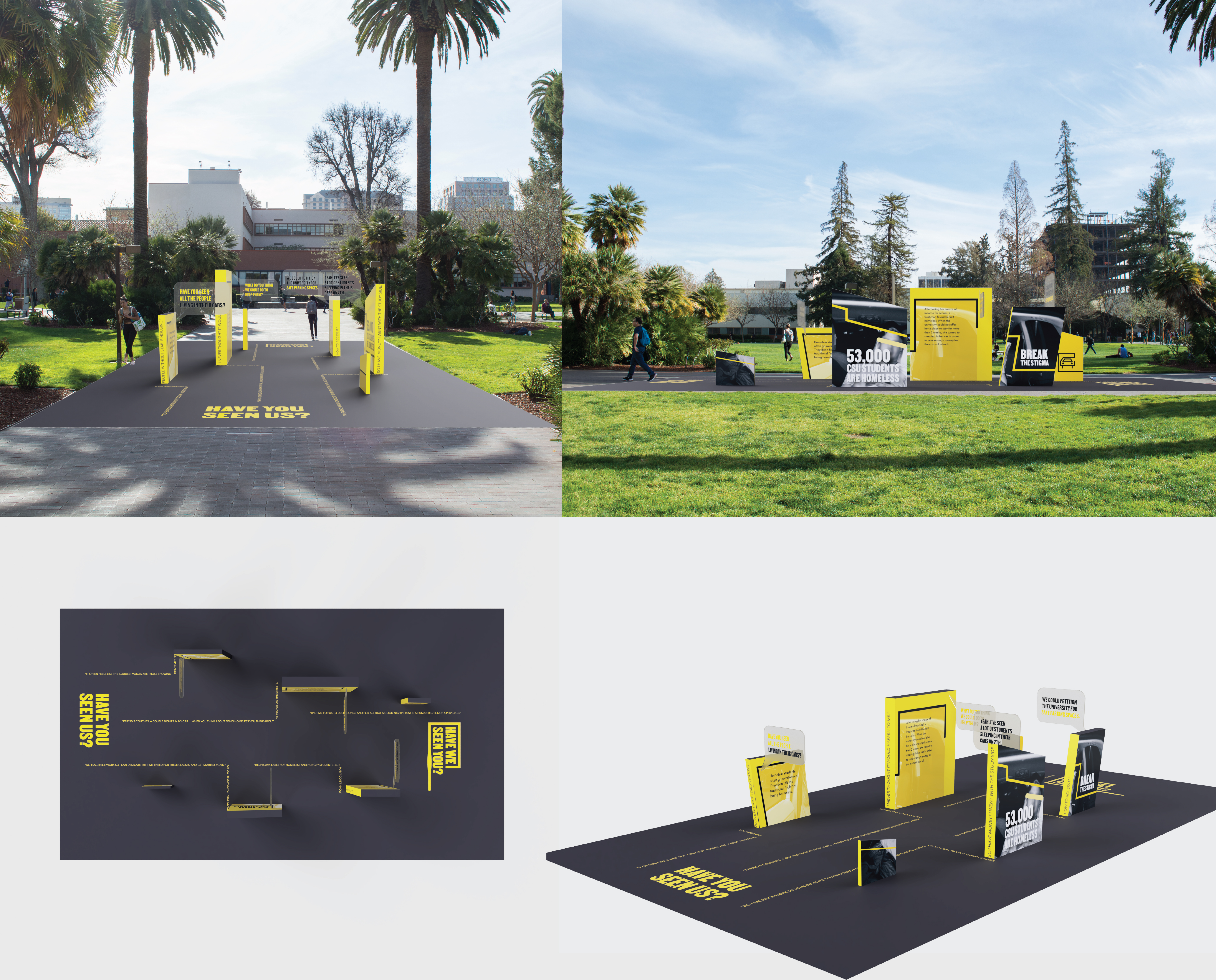
Have You Seen Us?
Thesis Project
Thesis Project
Unlike many typical issues facing college students, housing insecurity and homelessness are issues that often go unnoticed within the college system. San José State University resides in Silicon Valley, where the median rent price is $3,400 and other costs of living have skyrocketed with the growth of the area. University costs on top of the cost of living has pushed many students into forgoing basic needs to stay enrolled, with an estimated 4,000 students facing some degree of housing insecurity. Many students have reported sleeping in their cars after facing unjust eviction or being turned away from on-campus housing, while others “couch surf” at friends’ places or sleep in the Martin Luther King Jr. Library overnight. A fear of judgment from their peers often keeps unhoused students from seeking help. In addition, not much help is provided by the university, which lacks adequate amounts of beds and funding for students in housing crisis situations.
With this thesis project I intend to bring visibility to the complex issues faced by homeless and housing insecure students at San José State University. In order to do this, I will research the complex issues that these student populations face, and seek out knowledge from professionals who work with homeless students. I strive to translate this information into a visual format that will communicate the issues to the greater campus community, thus bringing awareness to the problem.
With this thesis project I intend to bring visibility to the complex issues faced by homeless and housing insecure students at San José State University. In order to do this, I will research the complex issues that these student populations face, and seek out knowledge from professionals who work with homeless students. I strive to translate this information into a visual format that will communicate the issues to the greater campus community, thus bringing awareness to the problem.


Research and Development
In order to correctly represent the issues faced by homeless students, I conducted extensive research into local and statewide issues of student homelessness. This research led me to sources such as research conducted by the California State University system, which estimated that 10.9% of it’s students were homeless or housing insecure. The study also revealed that students who did not have their basic needs of housing, food, healthcare, and education met were more likely to drop out or have lower grade point averages than students whose basic needs were met. In addition to statistical research, I also attended events, such as Poverty Under The Stars hosted by the SJSU Student Homeless Alliance, to gain first hand accounts of the problems that homeless students face here at SJSU from local leaders.
After researching, I decided that an installation would be the best way to catch the attention of the campus community. I began my explorations by thinking about both virtual and physical installations. Through many iterations, I found that the most powerful imagery is that of the protests that took place on campus in 2019, so I decided that protest signs would be the basis for my installation form. Protest signs are a timeless form of communication in bringing awareness to difficult issues of human rights, like homelessness.

Narritive and Stories
As I continued the visual development of my thesis, I worked on developing the content. My research had revealed a complex amount of different stories and perspectives on student homelessness. In order to accurately address these issues, I decided to have three rotating forms for the installation that would cover the main issues of student homelessness, following an overarching narrative:
When we talk about homelessness, what do you see?
Your mental image is probably that of the scruffy beggar on the corner. But homelessness can affect anyone at any time. There are 53,000 homeless students in the CSU system. Homeless students often go overlooked as they don’t fit into the traditional “role” of homelessness. They sleep in their cars, the library, or crash on friend’s couches, while still attending their classes. They often suffer silently, as the stigma surrounding homelessness can make them feel isolated and humiliated. They have a right to have their basic needs met: food, housing, healthcare, and education. Students facing issues of homelessness often have lower GPAs, delayed graduation, and higher dropout rates than housed students. The stress of not having their basic needs met is cited as the reason for academic struggles. There is also a lack of awareness about services on campus that help students struggling with housing and food insecurity. However, the services on campus are also lacking: there are not enough emergency beds or safe overnight parking spaces, and there is currently not a centralized location to receive assistance with services.
When we talk about homelessness, what do you see?
Your mental image is probably that of the scruffy beggar on the corner. But homelessness can affect anyone at any time. There are 53,000 homeless students in the CSU system. Homeless students often go overlooked as they don’t fit into the traditional “role” of homelessness. They sleep in their cars, the library, or crash on friend’s couches, while still attending their classes. They often suffer silently, as the stigma surrounding homelessness can make them feel isolated and humiliated. They have a right to have their basic needs met: food, housing, healthcare, and education. Students facing issues of homelessness often have lower GPAs, delayed graduation, and higher dropout rates than housed students. The stress of not having their basic needs met is cited as the reason for academic struggles. There is also a lack of awareness about services on campus that help students struggling with housing and food insecurity. However, the services on campus are also lacking: there are not enough emergency beds or safe overnight parking spaces, and there is currently not a centralized location to receive assistance with services.
Story #1
Students Living in Their Cars
After losing her source of income for school, a freshman found herself homeless. When the university could not offer her a place to stay for more than 2 weeks, she turned to sleeping in her car in order to save enough money for the costs of school.
Students Living in Their Cars
After losing her source of income for school, a freshman found herself homeless. When the university could not offer her a place to stay for more than 2 weeks, she turned to sleeping in her car in order to save enough money for the costs of school.
Story #2
Home is Far Away
Unable to afford a room in San Jose, a masters student commutes 3 hours to the university. On days where he cannot make the train home, he must sleep in the library or find a friend with an open couch to stay the night on. The stress of trying to stay afloat financially, commute, and find safe shelter makes keeping up with his academic work a problem. He struggles to stay focused and keep his grades up.
Home is Far Away
Unable to afford a room in San Jose, a masters student commutes 3 hours to the university. On days where he cannot make the train home, he must sleep in the library or find a friend with an open couch to stay the night on. The stress of trying to stay afloat financially, commute, and find safe shelter makes keeping up with his academic work a problem. He struggles to stay focused and keep his grades up.
Story #3
Even Emergency Housing Has a Price
Upon reaching out to the university, a recently homeless student is told that there are no vacant rooms or beds available immediately. They are told that there is a waitlist, and when a bed does become available there is a $650 application fee just to be considered. When they point out that they cannot afford that fee, they are told to look elsewhere for housing.
Even Emergency Housing Has a Price
Upon reaching out to the university, a recently homeless student is told that there are no vacant rooms or beds available immediately. They are told that there is a waitlist, and when a bed does become available there is a $650 application fee just to be considered. When they point out that they cannot afford that fee, they are told to look elsewhere for housing.

Outcome
The final outcome features photography and iconography to denote the different stories. All photography was kept anonymous, to contribute to privacy for those affected by these issues, and to help prevent implicit biases from affecting the perception of these stories. It also had the addition of the “speech bubbles:” these bubbles have a different hypothetical conversation about the problem at hand, and what we can do to help. This “conversation” is intended to help viewers start their own conversations about the topic.
The location for the installation was also a vital part in communicating the issues of student homelessness to the campus community. Tower Hall and the accompanying Tower Lawn are one of the most iconic areas of campus life to SJSU Students. It’s a picturesque view of student life—games of frisbee and volleyball, study groups meeting on the grass, even the occasional hammock strung up between trees. These factors make it the perfect place to stage the installation, which strives to make the point that any one of the students seen around this mecca of campus life may be struggling with issues of homelessness. Having an installation in the middle of an area like Tower Lawn also draws a lot of attention, which is important for drawing in an audience to an otherwise invisible topic.
The location for the installation was also a vital part in communicating the issues of student homelessness to the campus community. Tower Hall and the accompanying Tower Lawn are one of the most iconic areas of campus life to SJSU Students. It’s a picturesque view of student life—games of frisbee and volleyball, study groups meeting on the grass, even the occasional hammock strung up between trees. These factors make it the perfect place to stage the installation, which strives to make the point that any one of the students seen around this mecca of campus life may be struggling with issues of homelessness. Having an installation in the middle of an area like Tower Lawn also draws a lot of attention, which is important for drawing in an audience to an otherwise invisible topic.

Conclusion
I took the opportunity with this project to really challenge myself with a problem near and dear to my heart. Finding a way to help communicate the issues that homeless students face in order to bring them visibility is no small feat, and many have attempted it before myself. Campus is a busy place, with students moving from class to class there isn’t much room for pausing and reflecting. That’s why I strove to create something that could be seen in passing but still spark the bigger conversation: how can we bring visibility to those who need it most?
While I cannot solve this on my own, I hope that the message behind this thesis project serves to make people take pause and really consider the issues at hand, and how we as a community can come together and make a change in the way student homelessness is seen and handled in the local university system.
While I cannot solve this on my own, I hope that the message behind this thesis project serves to make people take pause and really consider the issues at hand, and how we as a community can come together and make a change in the way student homelessness is seen and handled in the local university system.
© Helen Frost ︎ ︎
